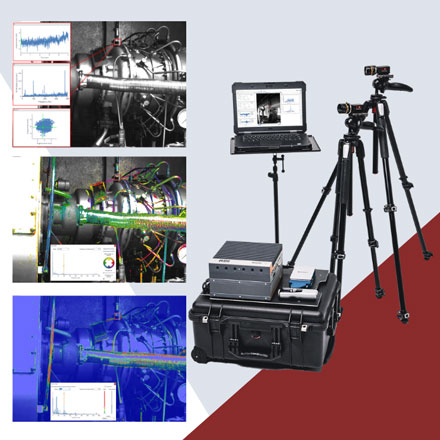|
|
Presented by
|

|
|

|
Motion Amplification® is a camera-based full-field motion and vibration technique that detects subtle motion and enhances it to a level visible to the naked eye, resolving motions as small as 250 nm. The method enables visualization and measurement across large fields of view with 100% coverage by utilizing the millions of pixels in modern cameras and turning them into data points from which to extract motion.
Jeff Hay provides a comprehensive look at Motion Amplification® as well as a range of new techniques that produce multiple layers of data extracted from video to help users better understand the motion in a scene. He discusses how frequency, amplitude, and phase — which are fundamental to vibration — can be quantified and visualized.
Hay uses example data to demonstrate motion and phase maps on real-world targets. Motion maps produce Vibragrams, which are colorized images of motion that visualize the contribution of that motion at a given frequency across an entire scene. Phase maps produce colorized images of phase that visualize the phase at a given frequency across an entire scene by mapping each phase angle to a specific color.
Hay discusses several additional novel techniques, including applications for measuring rotating components and thermal growth. Rotating objects are traditionally difficult to measure using cameras because these objects change position or move in and out of the field of view. Nonsynchronous motion and vibration can be directly visualized and measured using a laser tachometer that can be synchronized to the camera to eliminate the synchronous component of motion in the rotating object. For thermal growth and visualization, long, time-based video capture can be leveraged through Motion Amplification®, enabling the subtle motions that occur during wide temperature changes to be seen.
Who should attend:
Researchers and engineers who work with motion control technology, cameras, and sensors. Those who work in manufacturing and production, quality control, and test and measurement. Application areas include aerospace, agriculture, automotive, defense, machine vision, medical, semiconductors, and environmental work.
About the presenter:
Jeff Hay, Ph.D., is the founder and CEO of RDI Technologies. He holds a doctorate in physics from the University of Louisville. He is the inventor and visionary behind Motion Amplification® and the Iris M, which allow users to amplify and measure motion with the use of video. Hay's technology is moving vibration to the visual spectrum. He has a passion for using his background in applied optical technology to change the way motion is seen and measured.
About the sponsor:
RDI Technologies is pioneering a way for cameras to become the sensors of the future. RDI's Motion Amplification® technology allows users to see and measure motion that is impossible to see with the human eye and could previously only be measured by using contacting sensors. RDI’s products use standard video technology along with patented methods and processing algorithms to extract meaningful data. The company's technology turns every pixel in the camera's view into a virtual sensor capable of measuring vibration or motion with subpixel accuracy. By turning what used to be complex data into easy-to-understand videos, RDI enables quick problem-solving.
|
|
|
|
Date: Tuesday, April 19, 2022
Time: 1:00 PM - 2:00 PM EDT
Space is limited. Reserve your Webinar seat now at: https://attendee.gotowebinar.com/register/7914465438386057997?source=Eblast
After registering you will receive a confirmation email containing information about joining the Webinar.
|
|
|
SYSTEM REQUIREMENTS
Operating System
Windows® 7 or later, Mac OS® X 10.9 or later, Linux®, Google ChromeTM OS
AndroidTM OS 5 or later, iOS® 10 or later
Web Browser
Google ChromeTM (most recent 2 versions)
Mozilla Firefox® (most recent 2 versions)
Mobile Devices
AndroidTM 5 or later
iPhone® 4S or later
iPad® 2 or later
Windows Phone® 8+, Windows® 8RT+
|
|
|
|
.: More from Photonics Media
|
|
|
|